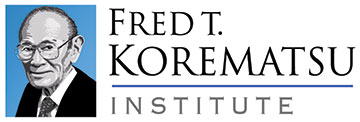Korematsu Institute
Statement for Cranes For Our Future
“One compassionate heart can create small peace around you. Small peace can then to lead big peace in the end. Sadako taught us how important it is to have a “Compassionate Heart” for her dear life. I believe this compassionate heart is the thing each of us need to keep in our minds. And folding paper cranes can be the first step to connect our hearts together.” –
Masahiro Sasaki*
Mothers walking with their young children. A boy riding on his bicycle eating a snack. People lining up to ride a trolley. Flowers blooming. A man fishing on the bank of the river. Moments from any city in the world are captured in flickering black and white 16 mm. However, these women are wearing kimonos, the blooming flowers are cherry blossoms waving over the city, and paper signs hang over shops in these city scenes in kanji. The city is Hiroshima, bustling with life, children laughing, and people going about their day. This video footage of an unremarkable day in Hiroshima was filmed by a resident almost ten years before the atomic bombing and is the only footage the Hiroshima Peace Museum owns that depicts the city before its destruction in 1945.**
On August 6, unprecedented devastation visited the unsuspecting residents of Hiroshima, and then three days later, Nagasaki. Some were killed instantly where they stood, some were burned with radiation, some died days, weeks, and months later never finding their missing friends and family, some developed cancers years later, some of the next generations were born with birth defects, and some still carried the scars of radiation burns and the marks of their clothing seared into their skin for the rest of their lives. Children like Sadako Sasaki, only two years old when the skies darkened over Hiroshima, survived to age 12. But she only survived to die of leukemia, known as the “A-bomb disease,”*** from the massive radiation that racked her body on that day joining the other 140,000 people lost.****
The threat of nuclear war is not just borne of a conflict between two ideologies or two cities or even two nations. It does not spark, flicker, and die in isolation. Between treaties and retaliation, it would burn around the globe affecting billions of people. It would grow and would explode into global ruination. The start of any modern-day nuclear conflagration would mean the end of life on our planet as we know it. This is not one group or one country’s fight. This is about all of us. Families who walk along city streets with their children. Fishermen who go fishing on a sunny afternoon. Workers lining up to get on a trolley car to take them to their destination. Kids riding their bicycles and enjoying a snack. We cannot allow another act of destruction like the two bombs that landed in Hiroshima and Nagasaki in 1945. We must work together to envision a world without the global threat of nuclear weapons hanging over our heads.
The Korematsu Institute is pleased to take part in the #CranesForOurFuture campaign that coincides with the somber anniversary of the bombings of Hiroshima and Nagasaki. The crane represents peace, hope, and long life, and the campaign encourages us all to envision a world without the threat of nuclear weapons. We must never forget the painful lessons of the past, but we must remember that history is a living and breathing thing we are creating right now. We can determine our collective future where the horrors of the past will never be repeated. We must work together to shape a sustainable, nuclear-free future for us all and relegate this horrific legacy to the history books of stories we teach to the next generation so they too, learn to never repeat it.
* “Masahiro Sasaki: on surviving the atomic bombing of Hiroshima, his sister Sadako and his mission to advance peace.” Masahiro Sasaki. https://theelders.org/news/masahiro-sasaki-surviving-atomic-bombing-hiroshima-his-sister-sadako-and-his-mission-advance
** “Rare footage shows daily life in Hiroshima before the atomic bomb was dropped on it.” Yvette Tan, July 11, 2017, Mashable.com, https://mashable.com/video/hiroshima-rare-footage
*** “The Story of Sadako Sasaki and the Hiroshima Peace Cranes.” 27 July 2020, Theelders.org, https://theelders.org/news/story-sadako-sasaki-and-hiroshima-peace-cranes
**** Hiroshima: The medical aftermath of the day that changed the world, Editor, Jo Hartley
Hiroshima: The Fallout
You can read our full statement on the July Theft of the Sadako Sasaki Statue in Seattle here: https://korematsuinstitute.org/theft-of-the-sadako-statue-in-seattle/
